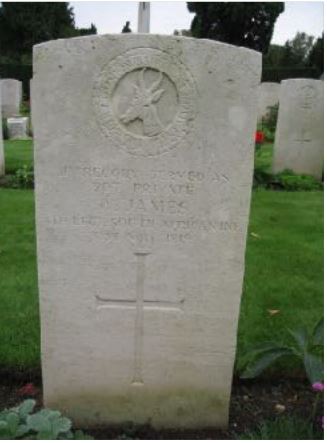4th Regiment, South African Infantry

As is so often the case with soldiers who used an alias during their army service, there is a lot of mystery surrounding Private John Gregory.
It would appear that he was born in Cheltenham in the third quarter of 1866, the son of John Gregory (a builder’s labourer) and his wife Eliza. The 1881 Census showed the family (which included John (age 16) and brothers Arthur (13) and Thomas (9) living at Bath Court Cottage, Cheltenham. It has not proved possible to identify John Gregory (junior) in any subsequent census.
There are various reports of a John Gregory appearing before the County Petty Sessions, for minor criminal offences. However, it cannot be said with any certainty that this is the same person who is buried in Gloucester Old Cemetery.
The CWGC Register states that John Gregory was the husband of E T Gregory of 1 Crowthers Cottages, Malvern Street, Cheltenham. A search of the UK Register of Marriages indicates that John Gregory married Emily Theresa Gibbs in 1896 in Cheltenham.
The Gloucestershire Chronicle of 10 September 1898 carried a report of a County Petty Sessions hearing, whereby a William Parsloe was summonsed for having hit an Emily Gregory on the nose, causing blood to flow, after she had given him ‘just a bit of a tap in the mouth’, after Parsloe had made ‘an observation’ to her when she went to an inn, in Brookthorpe, to fetch cider for her husband on 25 August 1898. John Gregory was referred to as her husband. A similar case of assault, involving Emily was reported in the Gloucestershire Echo of 22 March 1900. Emily Gregory’s name (again we cannot be absolutely certain, this is the same person) appears on four occasions in 1904 and 1905, in the local press, having been fined for using foul and abusive language in public. An Emily Gregory does appear in the 1901 Census, as living with the Williams family at 3 St Paul’s Street, Cheltenham.
Soldiers who assumed an alias for service normally did so because they had something to hide — possibly a criminal record, deserting a wife, a paternity issue or perhaps to escape a creditor. No evidence has emerged as to why John Gregory chose to serve under the name of William James and, in the absence, of any service record, how, when and where he came to join the South African Army.
Two records have survived, both in name of William James, which do give some useful information. He has a Medal Index Card and this states that he was discharged under King’s Regulation XVl — which indicates that he was ‘no longer fit for war service’. It also notes his address as 3 Bull Head Yard, St Mary’s Square, Gloucester. There is also confirmation that he had been issued with a Silver War Badge, to confirm discharge due to medical reasons and this states that he enlisted on 10 August 1915 and was discharged on 1 May 1917. It also mentions age being a factor (he would have been just short of 51).
The 4th Regiment of South African Infantry was also known as the South African Scottish and were raised from the Transvaal Scottish and Cape Town Highlanders; they wore the Atholl Murray tartan. The South African Infantry Brigade, of which the 4th Regiment was part, left Cape Town between 28 August and 17 October 1915 and by November all units were in the UK, the infantry being based at Bordon Camp. On 30 December 1915 it sailed for Alexandria in Egypt but during 13-15 April 1916 it sailed for Marseilles, earmarked for the Western Front, joining the 9th (Scottish) Division at Steenwerke, Flanders. During the afternoon of 14 July 1916, the Brigade attacked the German trenches at Delville Wood, Longueval, as part of the Somme Offensive. Fierce fighting ensued and only about 750 of around 3150 troops answered roll call, following relief on 20 July. The remainder of 1916 was spent recovering in the Arras sector.
Possibly John Gregory had travelled to South Africa, for reasons unknown and decided to join up to fight, probably lying about his age (he would have been 49 on enlistment) and an alias would have been the perfect way of disguising his identity, for that reason alone.
Obviously, his true age was discovered and it would appear that he was discharged from the army and re-settled in the UK. No papers regarding a possible army pension have survived*
John Gregory/William James died at the Royal Infirmary, Gloucester on 31 May 1919, aged 52. A ‘Death Notice’ to this effect was placed in the Gloucestershire Journal on 7 June 1919, stating his age to be 52 and address 25 Pitt Street, Gloucester. He was buried inside what is now the World War One CWGC plot in Gloucester Old Cemetery, where a standard CWGC headstone (bearing both real and assumed name) marks his grave.
Gloucestershire burial records indicate that an E T Gregory died in December 1924 and was buried in Cheltenham Cemetery on the 18th of that month, having been living at 56 Stanhope Street, Cheltenham: her age was stated to be 51.
*In 2019 an agreement between The Western Front Association and the Ancestry website saw the release of Pension Record Cards through the ‘Fold 3’ search engine. These did include some records of South African soldiers and there is a card for ‘William James — alias John Gregory’. It confirms that he had a wife named Emily, living at 25 Pitt Street, Gloucester, his date of death as recorded by the CWGC and the fact that he was discharged. The most interesting item is his date of birth, recorded as 13 July 1875. This was nine years later than what is believed to be his actual birth and would have made it appear to the recruiting authorities that he was 39.
Researched by Graham Adams 5 April 2017 (revised 27 December 2019)
